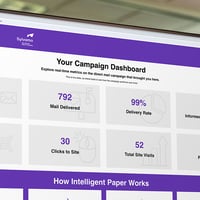Meet Your Sheet: 6 Features Designers Should Consider When Specifying Paper for Commercial Print

Every job has the perfect tool, and the same holds true for designers when it comes to selecting the right paper for a specific project. However, the challenge is understanding the features that designers need to account for relative to the print process or industry application. Not only can this understanding help designers maximize the performance of their print project, it also creates a more collaborative relationship with your print provider.
With this in mind, let’s look at six key features designers should look for when specifying the right paper for their commercial print needs.
Function
Designers can’t just think about how your printed piece needs to look; they also have to think about how the print piece will function, how much it will be handled and if it will be exposed to the elements.
For example, if you’re planning to write on the piece, you’ll want to avoid a coated, glossy paper. If there’s the risk your printed piece will get wet, you’ll want to opt for either a supplemental coating or specific materials that are more resistant to water. You also want to consider whether your piece will include any folds or finishings.
Once you determine the functionality of your printed piece, you can move on to the additional considerations.
Thickness and Weight
Thickness and weight of paper go hand in hand, as together they determine how sturdy and durable the paper will be. A thicker paper with a higher weight will be able to stand up to more handling and wear and tear than a paper of lower weight or less thickness.
Not only that, but the tactile nature of thicker paper provides a more substantial feel, and can enhance the perceived value and quality of your piece. Thicker paper also provides the opportunity to incorporate a wider variety of finishes like die-cutting, embossing and foil stamping without the worry of it bleeding or showing through.
Brightness and Opacity
The brightness of your paper affects how readable it will be — higher brightness usually means greater readability due to the fact that there’s a greater contrast to darker inks. Ink also appears more vibrant than those printed on a paper with less brightness, which runs the risk of dulling and muddying the colors.
With opacity, designers have to consider the transparency of your printed pieces, or how much print will show through from the front of the piece to the back. When designing a piece, it’s important to keep in mind that the higher the opacity — like what you get with Accent® Opaque Text — the greater the ink coverage and lower risk of see-through.
Coatings
There are two types of paper — coated and uncoated. With uncoated paper, you’re provided with a better, non-glaring surface to write on, as ink more readily absorbs into the sheet due the fact that it doesn’t have anything covering up the paper’s natural fibers.
Coated paper, on the other hand, is more difficult to write on because it’s usually coated with a clay material that’s been hardened to the surface. However, it requires less ink since not as much is absorbed into the paper, which can result in sharper colors, details and images. Coated paper also offers a greater variety of finishes — everything from shiny gloss to dull or a non-shiny matte.
Sustainability
There’s never been a greater push towards sustainability in business practices than there is today, and consumers are increasingly looking towards brands to implement sustainable business practices. In fact, 78% of consumers consider sustainability to be important and 84% report that poor environmental practices will alienate them from a brand or company.
By choosing sustainably harvested and produced papers for your projects, you’re not only taking steps towards your own sustainability goals, but also demonstrating to current and potential customers that you’re an eco-friendly business invested in ethical environmental, social and community standards.
Affordability
Last but not least, you also need to take into consideration the affordability of your paper choice and its accompanying features. While a heavier, more expensive paper may cost more up front, it can pay off in the end by providing a durable product that can withstand wear and tear and project a high-quality image.
That doesn’t mean that standard papers are ineffective for your print projects; just that you have to consider everything — function, coatings, thickness, opacity, printing quantities — to ensure you’re setting yourself up for success and the best return on investment.
With these considerations in mind, designers will be well-equipped to have a more productive conversation with their print partners about the ideal paper for their commercial print projects. What’s more, this foundational understanding of paper can help you save time and money, and create a high-quality piece of print that best showcases the creativity and ingenuity of your design.
Learn more about how Accent Opaque’s premium, uncoated paper can help you create standout print pieces that matter.





